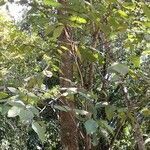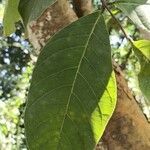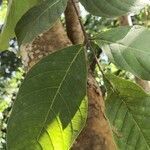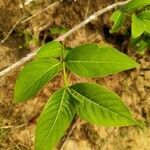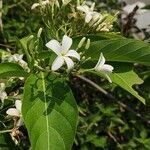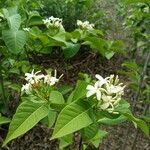Shrub or tree to 15 m. Branchlets pubescent or occasionally glabrous. Leaves: petiole 2-4 mm; blade papery when dry, elliptic, 4.5-27 by 2.4-11.5 cm, 1.2-3.8 times as long as wide, apex acuminate or acute, rarely obtuse or rounded, young leaves may be emarginate, base mostly cuneate, rarely obtuse, pubescent on both surfaces to glabrous, 7-20 pairs of secondary veins, tertiary venation scalariform and reticulate. Inflorescence appearing as an axillary cyme, rarely terminal, 3.8-9 cm long, lax, pubescent; bracts mostly deciduous, 1-4 mm long. Sepals ovate to linear, 1.8-4.2 by 0.8-1.3 mm, 1.5-4 times as long as wide, pubescent outside, pubescent or glabrous inside; colleters few or absent inside. Flowers fragrant. Corolla tube 8-14 by 1.6-1.7 mm, 0.6-1.2 times as long as lobes, 2.6-6.4 times as long as calyx; lobes 9-21 by 4-7 mm, 2.3-4.2 times as long as wide, obovate to elliptic, apex rounded. Stamens inserted at 2-2.3 mm from corolla base; filaments pubescent at base, 0.3-0.8 mm long; anthers 1.5-1.7 by 0.4-0.6 mm. Ovaries 0.6-1.2 mm long; style and style head 1.8-2.5 mm long. Fruit pendulous, 18-43 cm by 3-7 mm. Seeds glabrous, 13-17 by 1.3-3 mm, coma 23-50 mm long.
Shrub or tree 0.6–18 m high, deciduous; trunk 12–25 cm in diameter; bark smooth, lenticellate or rough and corky, pale to dark grey; wood soft; branchlets pubescent, rarely glabrous.. Leaves petiolate; blade ovate to elliptic, 1.7–23 cm long, 1.3–11.5 cm wide, acuminate or acute at the apex, cuneate or rounded at the base, pubescent to glabrous; petiole 2–12 mm long, often pubescent.. Inflorescences seemingly axillary or leaf-opposed, sometimes terminal, mostly pubescent; bracts 1.5–4.5 mm long; peduncle 0.9–1.7 cm long; pedicels 0.3–3 cm long.. Flowers with sepals elliptic to linear, 2–12 mm long; corolla tube white, 9–19 mm long, outside with ordinary and glandular hairs, rarely glabrous; lobes white, narrowly triangular, 10–24(–30) mm long, 3–8 mm wide, pubescent and ciliate or glabrous; stamens inserted at 1.5–2.5 mm from the base of the tube; pistil 1.8–3.1 mm long; style 0.3–1.2 mm long.. Fruits pale grey to dark brown, dotted with white, 20–38 cm long, 2–9 mm in diameter; seeds 9–16 mm long; tufts of hairs 25–45 mm long.. Fig. 31 (p. 91).
Shrubs or trees to 10 m tall. Trunk to 20 cm in diam.; branchlets with whitish, dotlike lenticels. Petiole 1-5 mm, grooved, glandular inside groove; leaf blade ovate or elliptic, 10-24 X 4-11.5 cm, membranous, pubescent, sometimes densely so abaxially, base rounded, apex acute or obtuse; lateral veins 10-15 pairs. Cymes 5-8 cm; peduncle 1-2 cm. Pedicel 0.3-3 cm. Sepals elliptic to linear, 2-12 mm. Corolla white, pubescent, tube 0.9-1.9 cm; lobes oblong, 1-3 cm. Anthers included, narrowly ovate, base rounded. Follicles linear, 20-43 X 0.5-1.5 cm, with whitish, dotlike lenticels. Seeds 0.9-1.6 cm, coma 2.5-4.5 cm. Fl. Apr-Jul, fr. Jun-Dec. 2n = 22.
A small tree or tall shrub. It loses its leaves. It grows 10 m tall. The bark is rough and pale grey and cracked. It peels off in irregular flakes. The leaves are thin and opposite. They are pale green and broadly oval. They are wedge shaped at the base. The flowers are white or cream. They are 3-4 cm across. They are in loose clusters. They are at the ends of twigs. The fruit are a pair of follicles that are curved and slender. They are 20-48 cm long and 6-8 mm thick. It opens to reveal many seeds.
Leaves very variable in shape and size; petiole pubescent or less often glabrous, 0·2–12 mm. long; lamina ovate to elliptic or narrowly so, 1·7–19·5 x 1·3–11·2 cm., acuminate or acute at the apex, cuneate or rounded at the base, pubescent to glabrous on either side: if hairy usually more so beneath; lamina of the leaves of the first pair or the first two pairs of a branchlet often subcircular, rounded or obtuse at the apex and smaller; on each side of the midrib with 5–25 secondary veins.
Sepals (1)2–12 x 0·5–1·7 mm., elliptic to linear, pubescent outside, often only towards the apex, indumentum a mixture of eglandular and glandular hairs, less often entirely glabrous, inside pubescent with eglandular hairs all over or only at the apex and then the basal 0·5–3 mm. glabrous, or less often entirely glabrous, ciliate, with 0–10 colleters inside at the base.
Corolla 20–38 mm. long; tube white 9–19 mm. long, pubescent outside with eglandular and also some glandular hairs except for the basal 0·5–3 mm., sometimes entirely glabrous, inside pubescent from the throat to the insertion of the stamens; lobes white, narrowly triangular, 10–24(30) x 3–8 mm., recurved, pubescent and ciliate or glabrous.
Pistil 1·8–3·1 mm. long; ovary 0·7–1·2 x 0·5–1·0 mm. glabrous; style 0·3–1·2 x 0·2–0·3 mm., shortly pubescent at the apex or entirely glabrous; clavuncula 0-3-1-2 X 0·2–0·5 mm., shortly pubescent or less often glabrous; stigma 0·1–0·3 mm. long, shortly pubescent or glabrous.
Small tree or shrub, up to 4 m high. Young branches ± pubescent, later glabrescent; dotted with lenticels. Leaves sparingly to densely pubescent; petioles with a few glands at base on inner surface. Fruit of 2 mericarps, follicular, 200-280 mm long. Flowers white.
Shrub or tree, 0·60–18 m. high; trunk 12–25 cm. in diam.; bark smooth and more or less distinctly lenticellate or rough and corky, longitudinally fissured, pale to dark grey; inner bark pale buff, with green outer layer, wood soft.
Peduncle, branches and pedicels pubescent or less often glabrous; peduncle 0·9–1·7 cm. long; bracts linear, pubescent or less often glabrous on both sides.
Fruits pale grey to dark brown; carpels pendulous, 20–37·5 cm. long, 2–9 mm. in diam., outside sometimes many lenticels or white-dotted or-spotted.
Inflorescences usually apparently axillary or leaf-opposed, sometimes terminal, fairly lax.
Seeds 9–16 mm. long, with a dense, 25–45 mm. long tuft of hairs at the apex.
Branches lenticellate; branchlets pubescent or less often glabrous.
Anthers narrowly triangular, 0·8–1·8 mm. long.
